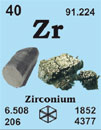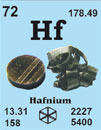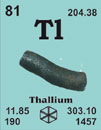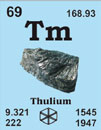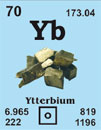Iod 53I126.904
1811 von B. Courtois in Paris, Frankreich, entdeckt.
[Griechisch, iodes = veilchenblau]
French: iode
English: iodine
Italian: iodio
Spanish: yodo
Beschreibung: Schwarzes, glänzendes, festes Nichtmetall, I2. Sublimiert leicht. Verwendet als Antiseptikum, in Arzneimitteln, für Futtermittelzusätze, Farbstoffe, Katalysatoren und in der Photographie.
Further Materials properties
| Crystal structure: |
(cell dimensions/pm), space group,
orthorhombic (a=726.47, b=478.57, c=979.08), Cmca
|
|---|
| X-ray diffractions mass absorption coefficients: |
CuKa 294 (µ/r) / cm2g-1
MoKa 37.1 (µ/r) / cm2g-1 |
|---|
| Neutron scattering length: |
0.528 b/10-12 cm |
|---|
| Thermal neutron capture cross-section: |
6.2 sa / barns |
|---|
| Density: |
4930 kg/m-3 [293 K]; 6113.6 [liquid at m.p.] |
|---|
| Melting point: |
113.55°C / 386.7°K |
|---|
| Boiling point: |
184.35°C / 457.50°K |
|---|
| Molar volume: |
27.74 cm3 |
|---|
| Thermal conductivity: |
0.449 [300 K] W m-1K-1 |
|---|
| Coefficient of linear thermal expansion: |
n.a. |
|---|
| Electrical resistivity: |
1.37 x 10-7 [293 K] Ωm |
|---|
| Mass magnetic susceptibility: |
-4.40 x 10-9(s) kg-1m3 |
|---|
| Radi: |
I- 196; covalent 133; van der Waals 215 |
|---|
| Electronegativity: |
2.66 (Pauling); 2.21 (Allred); 6.76 eV (absolute) |
|---|
| Effective nuclear charge: |
7.60 (Slater); 11.61 (Clementi); 14.59 (Froese-Fischer) |
|---|
| Number of Isotopes (incl. nuclear isomers): |
37 |
|---|
| Isotope mass range: |
110-> 140 |
|---|
Biological data
| Biological role: |
Most iodine exists in nature as iodide ions, I-, the form in which it is taken into our bodies. Iodine is essential to many species, including humans. |
|---|
| Toxicity |
|
|---|
| Toxic intake: |
2 mg as I2. Iodides are similar in toxicity to bromides. |
|---|
| Lethal intake: |
human, oral = 2g as I2. LD50 (NaI, oral, rat) = 14 000 mg Kg-1 |
|---|
| Hazards: |
Iodine in its elemental form, I2, is toxic, and its vapour irritates the eyes and lungs. The maximum allowable concentration when working with iodine is 1 mg m-3 in air. |
|---|
| Level in humans |
|
|---|
| Blood: |
0.057 ppm |
|---|
| Bone: |
0.27 ppm |
|---|
| Liver: |
0.7 ppm |
|---|
| Muscle: |
0.05 - 0.5 ppm |
|---|
| Daily dietary intake: |
0.1 - 0.2 mg |
|---|
Total mass of element in average
[70 kg] person: |
12 - 20 mg |
|---|
Geological data
| Minerals: | Minerals are very rare. Iodine cycles through the environment, and rain water contains about 0.7 p.p.b. |
|---|
| Mineral | Formula | Density | Hardness | Crystal apperance |
|---|
| Iodargyrite |
β-AgI |
5.69 |
1.5 |
hex., res./adam. colourless |
| Lautarite |
Ca(IO3)2 |
4.519 |
3.5 - 4 |
mon., col./yellow, transparent |
| Chief sources: |
from brines, which may have 50 ppm of iodide, and the Chilean nitrate deposits which contain up to 0.3% calcium iodate. Some iodine is also extracted from seaweed |
|---|
| World production: |
12 000 (elemental iodine) tonnes/year |
|---|
| Producing areas: |
Chile, Japan |
|---|
| Reserves: |
2.6 x 106 tonnes |
|---|
| Specimen: |
available as crystals. Warning! |
|---|
| Abundances |
|
|---|
| Sun: |
n.a. (relative to H = 1 x 1012) |
|---|
| Earth's crust: |
0.14 ppm |
|---|
| Seawater |
|
|---|
| Atlantic surface: |
0.0489 ppm |
|---|
| Atlantic deep: |
0.056 ppm |
|---|
| Pacific surface: |
0.043 ppm |
|---|
| Pacific deep: |
0.058 ppm |
|---|
| Residence time: |
300 000 years |
|---|
| Classification: |
scavenged as I(-I), recycled as I(V) |
|---|
| Oxidation state: |
-I and V, mainly V |
|---|
Source: Emsley, J. (1998) The Elements (3rd Edition)
Other sizes and specifications on request

 English
English
 Deutsch
Deutsch








































